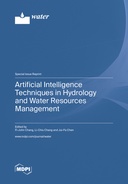Explore

Artificial Intelligence Techniques in Hydrology and Water Resources Management
0 Ungluers have
Faved this Work
Login to Fave
The sustainable management of water cycles is crucial in the context of climate change and global warming. It involves managing global, regional, and local water cycles, as well as urban, agricultural, and industrial water cycles, to conserve water resources and their relationships with energy, food, microclimates, biodiversity, ecosystem functioning, and anthropogenic activities. Hydrological modeling is indispensable for achieving this goal, as it is essential for water resources management and the mitigation of natural disasters. In recent decades, the application of artificial intelligence (AI) techniques in hydrology and water resources management has led to notable advances. In the face of hydro-geo-meteorological uncertainty, AI approaches have proven to be powerful tools for accurately modeling complex, nonlinear hydrological processes and effectively utilizing various digital and imaging data sources, such as ground gauges, remote sensing tools, and in situ Internet of Things (IoT) devices. The thirteen research papers published in this Special Issue make significant contributions to long- and short-term hydrological modeling and water resources management under changing environments using AI techniques coupled with various analytics tools. These contributions, which cover hydrological forecasting, microclimate control, and climate adaptation, can promote hydrology research and direct policy making toward sustainable and integrated water resources management.
This book is included in DOAB.
Why read this book? Have your say.
You must be logged in to comment.
Rights Information
Are you the author or publisher of this work? If so, you can claim it as yours by registering as an Unglue.it rights holder.Downloads
This work has been downloaded 87 times via unglue.it ebook links.
- 87 - pdf (CC BY) at Unglue.it.
Keywords
- 2D inundation simulation and real-time error correction
- agricultural resilience
- ANN
- anomaly detection
- artificial intelligence
- artificial neural network
- Artificial Neural Networks
- autoregressive model
- Bayesian neural network
- Chania
- CNN
- Copula
- daily temperature
- dam inflow
- deep learning
- deep reinforcement learning
- Early warning
- ELM
- ensemble
- fluvial
- Forecasting
- forecasting uncertainty
- GeoAI
- geomorphic
- GRU
- Huff rainfall curve
- hydraulic
- hydroinformatics
- hydrological
- hydrological extremes
- hydrological modeling
- hyperparameter
- LSTM
- Machine learning
- Markov model
- meteorological feature extraction
- modeling
- multi-model ensemble
- multi-step ahead forecasting
- multiple linear regression
- multivariate stochastic model
- Persian Gulf
- precipitation
- probabilistic streamflow forecasting
- rainfall time series
- random forest
- Regression analysis
- resource utilization efficiency
- RNN
- roadside IoT sensors
- self-organizing map (SOM)
- simulations of the gridded rainstorms
- smart microclimate-control system (SMCS)
- stochastic rainfall generator
- support vector machine
- sustainability
- system dynamics
- telemetry water level
- temperature generator
- temporary rivers
- threshold rainfall
- threshold runoff
- time series
- uncertainty
- Urban agriculture
- urban northern Taiwan
- variational inference
- Water quality
- water–energy–food nexus
- weather types and features
- XGBoost
Links
DOI: 10.3390/books978-3-0365-7784-5Editions

